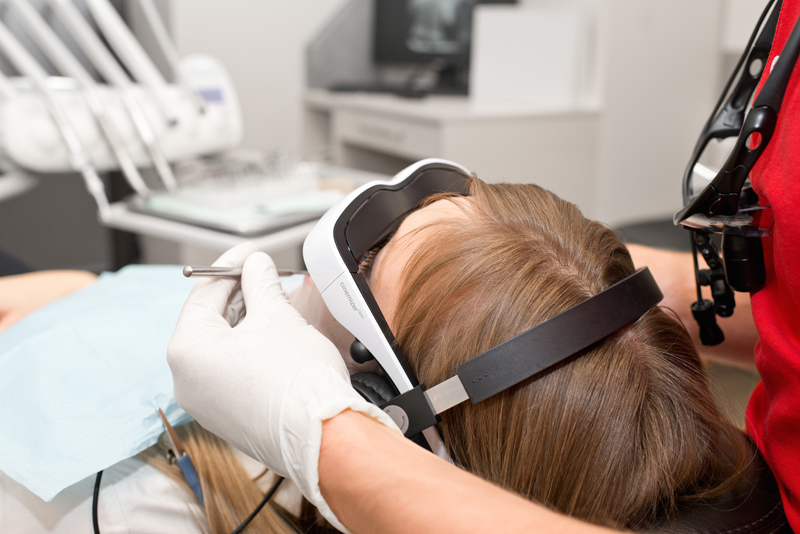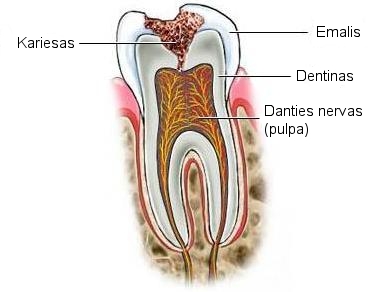Treatment of tooth decay
 According to the Guinness Book of Records, dental decay or caries is the most common non-infectious disease in the world. It is decomposition of dental tissue caused by improper oral hygiene and constant prevalence of carbohydrates in the nutrition. If untreated, the spread of dental decay may affect the dental nerve. In this case canals are treated, and later a tooth is filled and dentures are made. Therefore, not only proper cleaning of teeth but also a regular preventive examination is important.
According to the Guinness Book of Records, dental decay or caries is the most common non-infectious disease in the world. It is decomposition of dental tissue caused by improper oral hygiene and constant prevalence of carbohydrates in the nutrition. If untreated, the spread of dental decay may affect the dental nerve. In this case canals are treated, and later a tooth is filled and dentures are made. Therefore, not only proper cleaning of teeth but also a regular preventive examination is important.
What are the causes for dental decay?
The major cause for dental decay is probably the fact that the ingredients of food have changed but the culture of eating and hygiene skills hardly change. We constantly eat snacks that are rich in carbohydrates (“civilisation of snackers”). Nutrition is based on refined, rapidly digested and glutinous food products. Unnaturally sweet products are more often eaten. Bacteria present in the mouth decompose food carbohydrates (glucose, fructose, sucrose, etc.) into acids. When the concentration of acids becomes too high (pH 5.5 or lower), teeth start decaying.
A paradox is that the wealthier the society is, the unhealthier and more expensive food is eaten. It becomes unclear what is worse for health – lack of food or its excessive consumption.
Only a low percentage of people have strong teeth genetically which able to withstand constant presence of food in the mouth. Most of us have to be taught to choose food products (simple food which is rich in fibre somewhat cleans teeth naturally) from the very childhood, concentrate meals and stop snacking, properly clean teeth with a proper toothpaste twice a day after a meal, in case of more frequent meals, immediately rinse the mouth with water after each meal. It is necessary to learn to stop storing food in the mouth!
How to notice dental decay?
 Sometimes, dental decay can be impossible to detect without a dentist’s assistance, in particular when the disease is only starting or when it is present in the areas which are difficult to see (e.g. in-between teeth). However, upon detection of brown, greyish or black spots on the dental surface, an appointment to the dentist should be made. Teeth may react to temperature irritants, sour, sweet food. Having eliminated an irritant, pain usually also immediately disappears. It is as though a sign given by a tooth, a warning that it needs help. Normally, a superficial lesion is absolutely painless, yet one should not wait until severe pain starts. Therefore, a constant preventive examination in the dental clinic is required so that a lesion of the dental surface does not turn into a deep lesion which costs much to cure.
Sometimes, dental decay can be impossible to detect without a dentist’s assistance, in particular when the disease is only starting or when it is present in the areas which are difficult to see (e.g. in-between teeth). However, upon detection of brown, greyish or black spots on the dental surface, an appointment to the dentist should be made. Teeth may react to temperature irritants, sour, sweet food. Having eliminated an irritant, pain usually also immediately disappears. It is as though a sign given by a tooth, a warning that it needs help. Normally, a superficial lesion is absolutely painless, yet one should not wait until severe pain starts. Therefore, a constant preventive examination in the dental clinic is required so that a lesion of the dental surface does not turn into a deep lesion which costs much to cure.
How is dental decay treated?
One appointment is required to cure superficial dental decay. Such treatment is neither complicated nor painful, and the results are long-term. The most important task in treating dental decay is to remove affected tissues and restore integrity, function and aesthetics of the tooth. In modern dentistry is not a painful procedure. The tooth is filled with substances mimicking its natural colour. Fillings can restore not only teeth damaged by dental decay but also broken or worn teeth.
specialists Contacts Doctor's appointment


